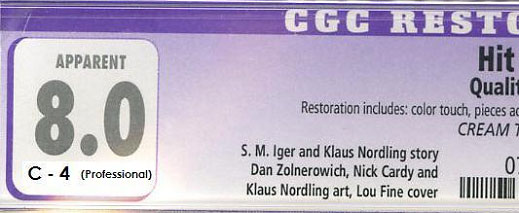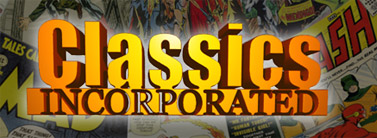GPA Article #4
Real World Examples and Summary
For the past three columns, we've proposed a new grading
scale for restored comics, breaking the steps into quality,
quantity, and pro vs. amateur (click here for articles
#1,
#2, and
#3). In this final
column, we tie it all together and show how it would look on
a CGC label.
In addition to expanding the number of categories used to
quantify the amount of restoration, we've added a scale for
judging the quality of restoration using the old grading
standards from school. The third factor is determining the
choice of materials used to restore the book, which is
simply noted as either "professional" or "amateur."
To summarize, here's how it goes:
Quality of
Conservation/Restoration
A - Outstanding Work
B - Excellent Work
C - Good Work
D - Fair Work
F - Poor Work
Quantity of Work
1 - Slight Conservation
2 - Slight Restoration
3 - Slight/Moderate Restoration
4 - Moderate Restoration
5 - Moderate/Extensive Restoration
6 - Extensive Restoration
7 - Qualified Extensive Restoration
Choice of materials
Professional - wheat paste, rice paper,
acrylic paint or watercolors
Amateur - markers, white glue, fixatives, bleach
Let's say we have three restored books that need to be
graded. The first is a Superman #1. It's determined
that the restorer used professional materials, and the
grader considers the restoration to be extensive, and of
excellent craftsmanship. He also determines the book to have
a VG/FN 5.0 appearance. The CGC label would appear like
this:

The Quality of restoration (B), and the Quantity of
restoration (6) are listed below the apparent grade. Next to
this appears the notation of "professional" to represent the
quality of materials used. Everything else on the label
stays the same.
Another example is a Hit #1 that is deemed to have
moderate restoration. The work is less than the Superman
#1, and the overall grade appears higher, but the grader
feels the quality of work is not as good. As a result, the
book receives a grade of 8.0, with a notation of C-4,
representing the quality and quantity of work:

The lower letters and numbers denote a higher quality
(and less restored) book, both factors that add value and
desirability.
The last book is a Human Torch #1 that has only
one tear seal to the interior. Nothing else had been done to
this book; no piece fill or color touch, and no cleaning.
All work was done with the sole intention of conserving the
book (other examples: rice paper support, piece
reattachment, deacidification, and staple replacement). No
aesthetic repairs were made.

The term A-1 certainly gives the impression that it is
the best. The breakdown of the scale can be further
explained on a website, with descriptions of each category.
The evolution of restoration over the past 40 years has
spun off a near limitless mix of techniques and books.
Expanding the categories to seventy possible combinations,
compared to only ten right now, will allow a more balanced
market for such a diverse, and relevant group of comics. |
